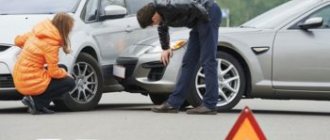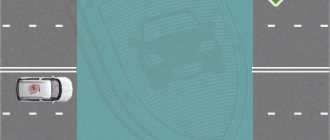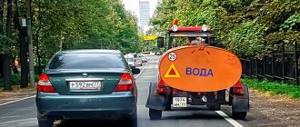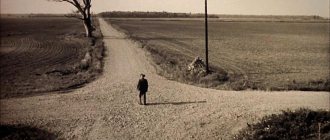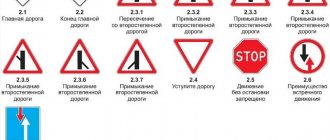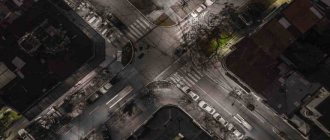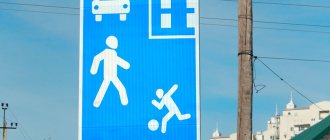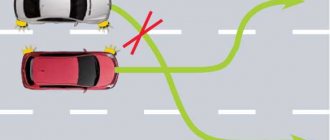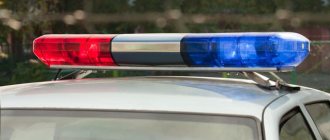Road accident concept
Surely every driver has an idea of what a traffic accident is and what its consequences may be. However, not every accident can be classified as a traffic accident, so we need an accurate definition. It can be found in clause 1.2 of the Traffic Regulations, Art. 2 Federal Law N 196-FZ, which is responsible for road safety, the Code of Administrative Offenses and the law on compulsory motor liability insurance.
An accident is an event involving a vehicle that occurs while driving on the road, resulting in injuries or deaths, damage to the vehicle and the cargo or structures it carries, or any other material damage.
Moreover, these “events” have their own classification, risk factors and different consequences. An accident must be recorded and documented according to the generally accepted procedure for road users and the traffic police.
How to determine who is at fault in an accident at an intersection
Disassembly after an accident is a fairly common occurrence. Everyone wants to prove that they are right in choosing the order of travel. Practice shows that it is especially difficult to identify who is to blame for an accident when turning left. True, there are often other options. But the State Traffic Inspectorate solves such problems, even if there are no video cameras. The one who violates the rules, which are described in detail in Art. 13 traffic rules.
When approaching an intersection, you need to take into account priority signs, rowing, markings and the presence of tram tracks. In addition, the following are considered general rules for competently negotiating an intersection:
- When turning (no matter in which direction), it is necessary to provide passage for pedestrians and passage for cyclists crossing the road.
- It is prohibited to enter an intersection with a congestion, which will certainly lead to a stop that will impede cross-vehicle flow.
On unregulated
At many of our intersections there is neither a traffic controller nor a traffic light. Often the latter does not work. In the rules, such road crossings are called unregulated. The culprit in an accident at this type of unequal intersection is determined by violation of priority signs.
The person at fault is considered to be driving on a secondary road and not allowing a vehicle to pass on the main road. The latter is not called that for nothing; it determines priority. If the main road changes direction, drivers are required to pass each other according to the rules for driving through equivalent intersections: if you see an obstacle on the right, stop, let them pass and drive calmly. The same principle works on secondary roads, even for trams.
When entering a circle, you must give way to all vehicles moving along it. When making a left turn/U-turn on an equivalent road, you should give way to all oncoming cars heading straight or to the right. This rule also applies to carriage drivers.
On adjustable
An intersection, the order of passage of which is determined by a traffic controller or a traffic light, is called a controlled intersection. When turning left/turning back at the permission signal, you also need to give way to oncoming vehicles moving straight or to the right. When moving along the arrow along with a yellow or red signal, you must let vehicles from other directions pass.
If a traffic light/regulator allows the movement of a tram and a car, then the former has priority. But on a switch with a red or yellow signal, the tram is also obliged to let vehicles from other directions pass.
The driver entering the intersection must complete the maneuver regardless of the signal. If, when turning in front of traffic lights, there are stop lines in the markings, you must obey the requirements of each of them. Even with a permitting signal, you are required to give way to vehicles and pedestrians who did not manage to complete their movement in a timely manner.
On unequal
On a secondary road, the driver must first always let those following on the main road pass, regardless of the direction of their movement. It's simple: I stopped, let it pass, then drove off myself.
You can tell which road is the main one by looking at the road signs and the quality of the surface. If there are no signs, and the quality of the surface cannot be visually determined (bad weather, visibility, etc.), you must assume that the road is of secondary importance.
On equivalent
At an unregulated equivalent intersection, the right-hand rule is used. The tram here enjoys an absolute advantage over other vehicles, regardless of the direction of travel.
Accident while turning at an intersection
The situation is considered classic. Typically, an accident occurs according to the following scheme:
- A driver who wants to make a left turn should drive into the middle of the intersection.
- The citizen crosses the lane and begins to perform the maneuver.
- The oncoming driver does not have time to react.
- As a result, a collision occurs.
Attention
Usually, traffic police officers in an accident when turning at an intersection find the person making the turn guilty of the incident. However, the specifics of the situation are taken into account. Sometimes the fault may be attributed to the driver who was driving straight ahead. For a complete explanation of the situation, contact an online lawyer on our website.
Uncontrolled intersection: collision when turning left and overtaking
Driving through an uncontrolled intersection is more difficult, because no one gives instructions in what order to drive. Therefore, in case of accidents in such places, it is more often possible to find the fault of each participant in the accident.
In addition to observing the order (priority of passage), it is necessary to take into account the possibility of overtaking a vehicle coming from behind. Overtaking is definitely prohibited at controlled intersections, but not always at unregulated intersections. In clause 11.4 of the traffic rules it is noted that overtaking is not allowed only on a secondary road and pedestrian crossings.
The fault of the driver making the turn
Any change in the direction of movement of the vehicle must be indicated by turn signals (Section 8.1 of the Traffic Regulations). If there are several lanes, the driver who sees another car on the right turning left must let it pass.
Before turning left, the driver must assess the situation and make sure that other cars behind and to the left will not interfere with him. If these conditions are not met, he will be found guilty in an accident.
The overtaking driver's fault
Even passing from the left lane often causes collisions with cars turning left at uncontrolled intersections, although overtaking is not prohibited here. Article 11.2 of the traffic rules states that overtaking is prohibited when the car in front has already turned left. If this is not noticed in time, the State Traffic Inspectorate will decide the issue not in favor of the “racer”. But traffic rules also prohibit preventing overtaking by increasing speed and so on. If the turning driver is caught doing something like this, he will be found guilty.
Controlled intersection: accident when turning left and overtaking
Even at a controlled intersection, you can get an unexpected side impact when turning left.
Driver's fault when overtaking
Overtaking at a signalized intersection is prohibited. Therefore, the driver of the overtaking car is found guilty.
Driver's fault when turning left
If the traffic light/traffic signal allowed the maneuver, the left turn signal was on, there were no obstacles on the left, the culprit is the driver who turned into the wrong lane (multi-lane road) or tried to overtake. If some rules were not followed by each participant in the accident, you will have to figure out who is more to blame. Logically, this is the first person to commit wrong actions and violate traffic rules.
Analysis of the cause of an accident at an intersection
When driving through a difficult area, the driver must control the space literally 360 degrees. After all, other vehicles are driving towards him and on both sides, they can overtake him if there is no traffic light in this area, turn and turn around. The causes of accidents that occur at intersections include:
- ignoring priority in traffic if the main and secondary roads intersect, or there are corresponding signs;
- driving one of the participants through red or yellow traffic lights;
- high speed contrary to the rules;
- overtaking where it is prohibited, or in the confluence of unequal roads;
- a controversial situation when one of the cars completes a maneuver at the intersection of the main and secondary directions.
Accident at an intersection when overtaking
If we generalize the factors of accidents at intersections, then this is ignorance of the rules or neglect of them, the driver’s lack of due attention to what is happening on the way.
Turn left: controversial situations
As is already clear, road accidents when overtaking and turning left at intersections are caused by a series of mistakes and violations of the rules committed by all its participants. This is where controversial issues arise. A simple example: a car intends to turn left on a yellow signal and has even started the maneuver, but the driver of the oncoming car ignored this and drove into his right side. Who will be guilty?
On the one hand, the first driver, because he did not let oncoming traffic pass. But on the other hand, he started his maneuver earlier, and the oncoming car could have started moving on a yellow rather than a green signal. This is where you have to prove your case to every driver. Almost everything is taken into account:
- traffic light markings and operation;
- the distance from the oncoming car to the intersection at the moment of starting movement;
- speed of both cars;
- the ability to apply emergency braking;
- whether the turn signal was turned on.
Testimony of witnesses (eyewitnesses), recordings of video recorders and surveillance cameras will help the traffic police inspector to correctly assess the situation. If the protocol does not satisfy one of the drivers, a department commission or even a court will decide who is guilty in a particular situation.
At a T-junction, when turning left from a secondary road onto the main road, a situation may also arise where both drivers are at fault. Suppose the first one arrived, stopped, turned on the turn signal, looked around and began to turn, but at that moment a car moving on the right crashes into him. The first one is guilty because he did not make sure that there was no obstacle or did not estimate the speed. The second one was driving too fast and either did not see or did not have time to brake. It is very difficult to determine who is right and who is wrong.
When leaving the side of the road, we actually make a left turn. And this is where disputes often arise. The driver leaving is obliged to turn on the turn signal and make sure there are no obstacles, and the driver moving along the road is obliged to let it pass or take all measures to prevent a collision.
Traffic regulations when turning left
There are traffic rules when turning left, mandatory compliance with which prevents accidents:
- When driving, the driver must take a position on the road that exactly corresponds to the planned left turn:
- The maneuver to the left must be performed from the leftmost lane.
- The maneuver near tram lines can be performed from the tracks if there is no obstacle to the passage of railway transport.
- Oncoming traffic when turning left is strictly prohibited and may result in a heavy fine or loss of your driver's license.
- If the maneuver to the left is carried out by a large truck, then, subject to safety precautions, deviation from some established rules is allowed.
For those making a left turn
Important requirements that must be met:
- The motorist cannot start driving immediately, therefore, before turning, he must turn on the turn signals in the appropriate direction. In addition, he gives a signal using his hand if the installed signs are faulty or they are missing on vehicles. The maneuver should not lead to an accident when turning left, and in addition it should not interfere with other moving cars.
- The light signal must be turned on first and turned off as soon as the turn is completed.
- The driver must give way to a vehicle moving straight ahead or to the right on an equivalent road.
- By giving a signal to perform a maneuver, the motorist does not receive any advantages relative to other car owners.
For overtaking and those in a hurry to overtake
- The driver can begin overtaking only if there is a free lane directly in the direction of overtaking and at a satisfactory distance for overtaking, when such a maneuver will not create an emergency situation for traffic and will not be an obstacle for other car owners.
- Overtaking is strictly prohibited if the car that is located in front and is moving has already given the appropriate signal to turn left;
Overtaking is considered strictly prohibited by the rules for:
- pedestrian crossing;
- areas where visibility is severely limited, for example, when climbing and on very dangerous turns, where there may be special signs;
- at railway crossings and approximately 100m before them;
- intersections where traffic regulation is carried out, and at uncontrolled intersections where the lane of an overtaking motorist is not considered the main one.
What to do after an accident
A detailed algorithm for the driver’s actions immediately after an accident is indicated in the traffic rules in the responsibilities section. It is clear that you cannot leave. You need to stop, turn on the emergency lights, set the triangle, and then assess the situation. If there are victims, provide first aid or take them to hospital. Then you need to call the traffic police, record the location of the cars and clear the roadway if possible.
Then you can look for eyewitnesses and inform the insurance company. Read about whether a certificate and notification of an accident are required.
